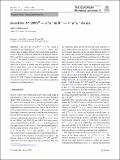| dc.contributor.author | Aaij, R. | |
| dc.contributor.author | Abdelmotteleb, A. S. W. | |
| dc.contributor.author | Beteta, C. A. | |
| dc.contributor.author | Abudinén, F. | |
| dc.contributor.author | Ackernley, T. | |
| dc.contributor.author | Adeva, B. | |
| dc.contributor.author | Adinolfi, M. | |
| dc.contributor.author | Adlarson, P. | |
| dc.contributor.author | Afsharnia, H. | |
| dc.contributor.author | Agapopoulou, C. | |
| dc.contributor.author | Aidala, C. A. | |
| dc.contributor.author | Ajaltouni, Z. | |
| dc.contributor.author | Akar, S. | |
| dc.contributor.author | Akiba, K. | |
| dc.contributor.author | Albicocco, P. | |
| dc.contributor.author | Albrecht, J. | |
| dc.contributor.author | Alessio, F. | |
| dc.contributor.author | Alexander, M. | |
| dc.contributor.author | Albero, A. A. | |
| dc.contributor.author | Aliouche, Z. | |
| dc.date.accessioned | 2023-08-01T16:30:01Z | |
| dc.date.available | 2023-08-01T16:30:01Z | |
| dc.date.issued | 2023-07-26 | |
| dc.identifier.uri | https://hdl.handle.net/1721.1/151714 | |
| dc.description.abstract | Abstract
The very rare
$${{D} ^*} (2007)^0\!\rightarrow {\mu ^+\mu ^-} $$
D
∗
(
2007
)
0
→
μ
+
μ
-
decay is searched for by analysing
$${{{B} ^-}} \!\rightarrow {{\pi } ^-} {\mu ^+\mu ^-} $$
B
-
→
π
-
μ
+
μ
-
decays. The analysis uses a sample of beauty mesons produced in proton–proton collisions collected with the LHCb detector between 2011 and 2018, corresponding to an integrated luminosity of 9
$$\text {\,fb} ^{-1}$$
\,fb
-
1
. The signal signature corresponds to simultaneous peaks in the
$${\mu ^+\mu ^-} $$
μ
+
μ
-
and
$${{\pi } ^-} {\mu ^+\mu ^-} $$
π
-
μ
+
μ
-
invariant masses. No evidence for an excess of events over background is observed and an upper limit is set on the branching fraction of the decay at
$$\mathcal{B}({{D} ^*} (2007)^0\!\rightarrow {\mu ^+\mu ^-} ) < 2.6\times 10^{-8}$$
B
(
D
∗
(
2007
)
0
→
μ
+
μ
-
)
<
2.6
×
10
-
8
at
$$90\%$$
90
%
confidence level. This is the first limit on the branching fraction of
$${{D} ^*} (2007)^0\!\rightarrow {\mu ^+\mu ^-} $$
D
∗
(
2007
)
0
→
μ
+
μ
-
decays and the most stringent limit on
$${{D} ^*} (2007)^0$$
D
∗
(
2007
)
0
decays to leptonic final states. The analysis is the first search for a rare charm-meson decay exploiting production via beauty decays. | en_US |
| dc.publisher | Springer Berlin Heidelberg | en_US |
| dc.relation.isversionof | https://doi.org/10.1140/epjc/s10052-023-11759-6 | en_US |
| dc.rights | Creative Commons Attribution | en_US |
| dc.rights.uri | http://creativecommons.org/licenses/by/4.0/ | en_US |
| dc.source | Springer Berlin Heidelberg | en_US |
| dc.title | Search for $$D^{*}(2007)^{0} \rightarrow \mu ^{+} \mu ^{-}$$ D ∗ ( 2007 ) 0 → μ + μ - in $$B^{-}\rightarrow \pi ^{-} \mu ^{+} \mu ^{-}$$ B - → π - μ + μ - decays | en_US |
| dc.type | Article | en_US |
| dc.identifier.citation | The European Physical Journal C. 2023 Jul 26;83(7):666 | en_US |
| dc.contributor.department | Massachusetts Institute of Technology. Department of Physics | |
| dc.identifier.mitlicense | PUBLISHER_CC | |
| dc.eprint.version | Final published version | en_US |
| dc.type.uri | http://purl.org/eprint/type/JournalArticle | en_US |
| eprint.status | http://purl.org/eprint/status/PeerReviewed | en_US |
| dc.date.updated | 2023-07-30T03:14:48Z | |
| dc.language.rfc3066 | en | |
| dc.rights.holder | The Author(s) | |
| dspace.embargo.terms | N | |
| dspace.date.submission | 2023-07-30T03:14:48Z | |
| mit.license | PUBLISHER_CC | |
| mit.metadata.status | Authority Work and Publication Information Needed | en_US |
